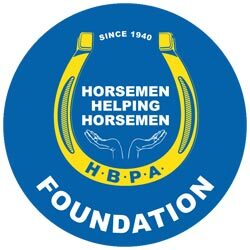Having a well-stocked first-aid kit and the skills necessary to use it can make all the difference when trouble arises
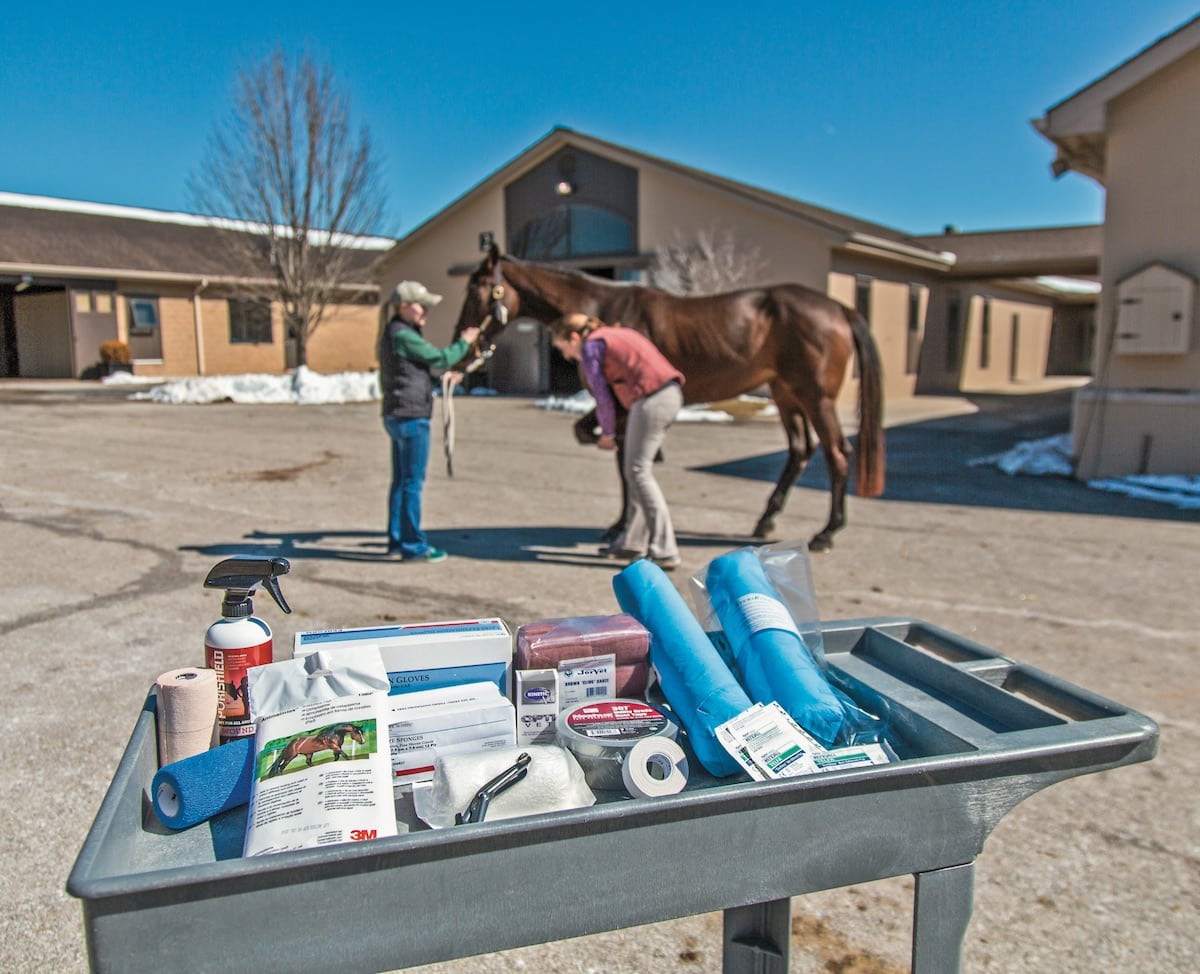
Your first-aid kit might include prescription and over-the-counter meds, wound care products, abscess supplies and useful tools. Courtesy The Horse staff
If you’ve been around horses long enough, you’ve surely joked that Bubble Wrap might be what it takes to keep your horse in one piece. Despite our best efforts to keep them protected from harm, horses remain injury-prone living creatures. The key is to be prepared. So, to give you and your OTTB the best chance of escaping unscathed when trouble arises, we’ve asked two equine veterinarians to put together the ultimate first-aid kit and help you make the most of this resource in your barn.
Elizabeth Barrett, DVM, MS, Dipl. ACVS, is a board-certified large animal surgeon and an FEI-treating veterinarian. She is the in-house veterinarian, focusing on lameness and emergency medicine, at Sweet Oak Farm, in Wellington, Florida. Jesslyn Bryk-Lucy, DVM, cAVCA, is the founder and owner of Leg Up Equine Veterinary Services, as well as resident veterinarian and assistant professor of equine science at Centenary University, both in New Jersey. They’ve shared their expertise to help you feel well-equipped to handle anything your ex-racehorse might throw at you.
Stock Your Kit
Have a complete, well-stocked first-aid kit, and know the purpose of each item.
Prescription-based medications
Your veterinarian will need to prescribe these medications for you and, ideally, you should speak with him or her on the phone about your horse’s condition before administering them.
■ Bute paste/powder This non-steroidal anti-inflammatory drug (NSAID) is the horseman’s go-to inflammation-reducer and musculoskeletal pain reliever.
■ Banamine paste/powder Another NSAID, Banamine is a top choice for managing pain related to eye injuries and colic.
■ Diclofenac (Surpass) Veterinarians recommend applying this topical NSAID directly to the skin to reduce swelling.
■ Trimethoprim/Sulfamethoxazole (SMZs) SMZs are broad-spectrum antibiotics and the first line of defense against many suspected or established infections, including cellulitis.
■ Oral sedation (i.e., Dormosedan gel) These drugs come in handy for certain situations (i.e., sheath cleaning, body clipping) to “take the edge off” a sensitive or fractious horse.
Over-the-counter products
■ Probiotics These support the gut’s microbiome when it is disrupted by stress, medication or a diet change.
■ Electrolyte paste/powder Electrolytes replenish levels of certain important minerals lost through sweat.
■ 60cc oral syringe Use this to administer oral medications.
First-aid supplies
■ Rectal thermometer You’ll need one to monitor the progression of an illness (colic, infection, heat stroke, etc.) or anytime your OTTB appears lethargic or is hot to the touch for no apparent reason.
■ Petroleum jelly This lubricant makes the thermometer’s entry into the rectum a little smoother.
■ Stethoscope You can use a basic, inexpensive stethoscope to obtain a heart rate and listen for gut sounds.
■ Exam gloves These create a protective barrier between you, the horse, bodily fluids and medications.
■ Tweezers Use them to remove ticks and superficial splinters.
■ Ice pack Icing an acute injury reduces inflammation.
Wound cleaning/bandaging supplies
■ Diluted betadine or chlorhexidine After flushing any debris or organic material from the wound, use one of these antiseptics to kill bacteria.
■ Rubbing alcohol Use it to “rinse” the antiseptic, which would dry out the skin if left unwiped.
■ Sterile saline Flush wounds involving sterile structures that could get infected from tap water (i.e., tendon sheaths, joints).
■ Clean towels Use these to apply pressure and stop bleeding.
■ Silver spray This “liquid bandage” seals wounds from external contaminants. It is an aerosolized solution rather than an ointment, meaning dirt, shavings and hair don’t stick to it.
■ Triple antibiotic ointment (Neosporin) This over-the-counter cream contains neomycin, polymyxin B and bacitracin. The combination of these three antibiotics is effective for wound healing.
■ Nonstick gauze pads (i.e., Telfa) These sterile pads often constitute the first layer of a wound bandage.
■ 4×4 gauze pads Use them to hold ointments against a wound, provide protection from environmental contaminants and add padding beneath the bandage.
■ Stretch conforming gauze roll (i.e., Kling) Many caretakers use it to hold a Telfa in place and/or to provide extra padding.
■ Self-adherent bandaging material (i.e., Vetrap or Elastikon) This is the glue to your bandage. It firmly holds together gauze pads and any ointments they contain.
■ Cast padding Designed to fit under casts, it conforms to the anatomy and snugly holds other bandaging materials in place, even in injuries that don’t need to be casted.
■ Cotton combine roll This thick bandaging layer affords cushioning and protection from external trauma.
■ Brown gauze rolls While commonly used to keep cotton combine roll bandages in place, be very careful to use even pressure. Because they have little ability to stretch, inappropriate application can damage soft tissues.
■ Standing bandages and pillow wraps Use these to prevent stocking up of the lower limbs. They also keep any dressings and bandages beneath clean and in place.
■ Bandage scissors Designed for safety, their rounded tip and special flat side prevent accidental slicing into the skin when cutting off bandages.
■ White first-aid tape Use it to label syringes, keep intravenous catheters in place, etc.
Hoof abscess supplies
■ Gauze and Vetrap/Elastikon They hold dressings and provide padding to the wrapped foot.
■ Baby diapers These can replace gauze and Vetrap in a hoof wrap but are less breathable.
■ Epsom salt and poultice pads These draw out abscesses.
■ Hoof pick Use one to clean the foot before soaking/wrapping it.
■ Nail pullers You’ll need these to remove a horseshoe that is loose or suspected to be causing lameness.
■ Clean bucket or feed pan Soak the foot in one.
■ Duct tape Use it to make the outer layer of a foot wrap (e.g., a duct tape star).
■ Hoof boot An alternative to duct tape, a medical boot can hold a foot wrap in place.
Other items
■ Headlamp You’ll appreciate one for those late-night emergencies and hard-to-see body parts.
■ Wire cutters Use these to free a horse trapped in wire fencing.
■ Nose twitch This provides fast-acting and effective restraint.
■ Spare halter, lead rope and nose chain Have these in case your horse’s gear breaks unexpectedly.
■ Fly spray Your veterinarian will appreciate not getting swished in the face by a horse tail.
■ Short piece of garden hose Slide it up the nostril at your veterinarian’s direction to keep the airway open when the face is swelling (e.g., in the case of a snakebite).
Documentation
■ Emergency numbers for the veterinarian, referral hospital, emergency shipper, farrier, dentist, barn owner, etc.
■ An emergency transport plan.
■ Your horse’s insurance information.
■ Written wish if you’re unreachable or incapacitated, addressing financial limits for veterinary care and permission to euthanize.
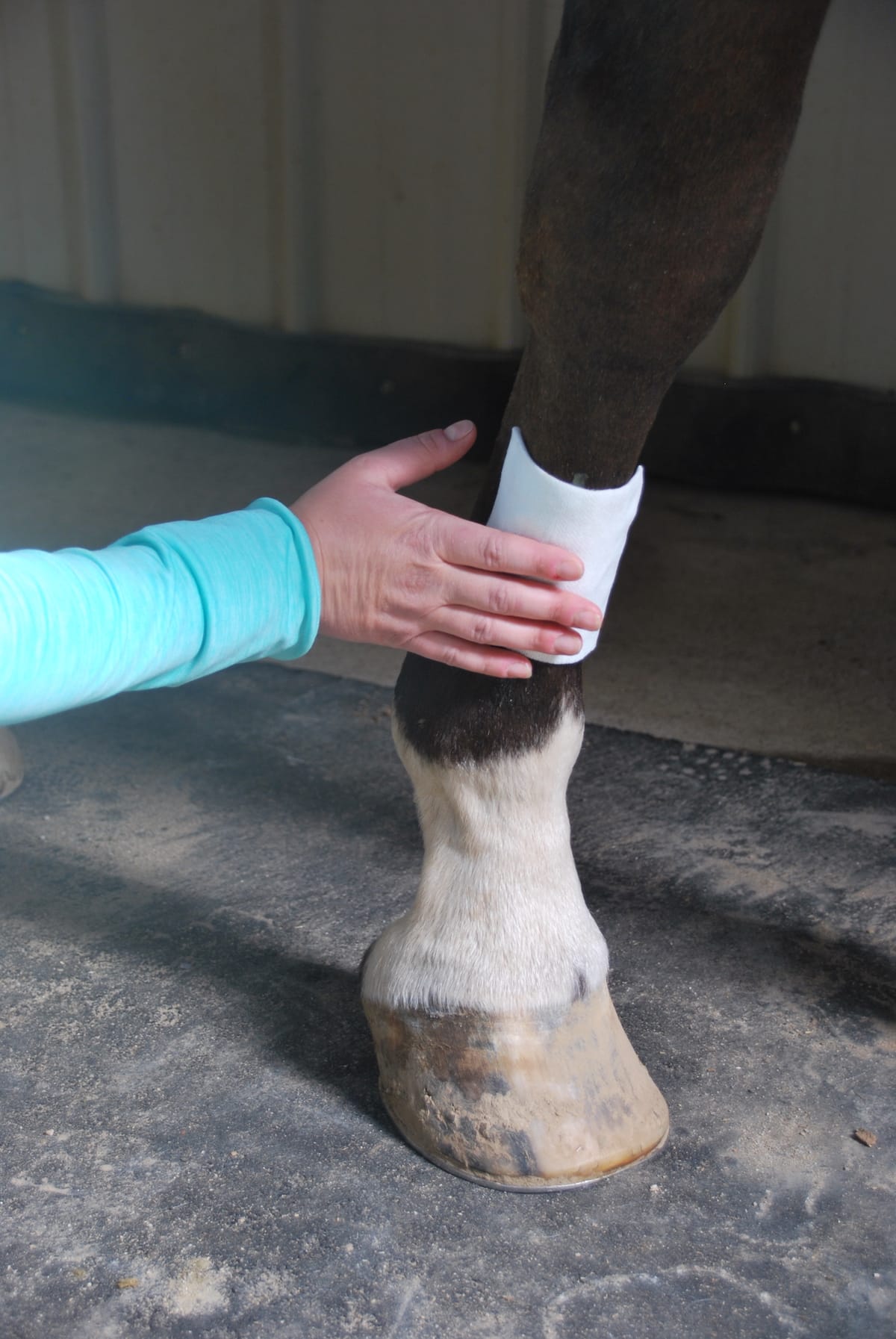
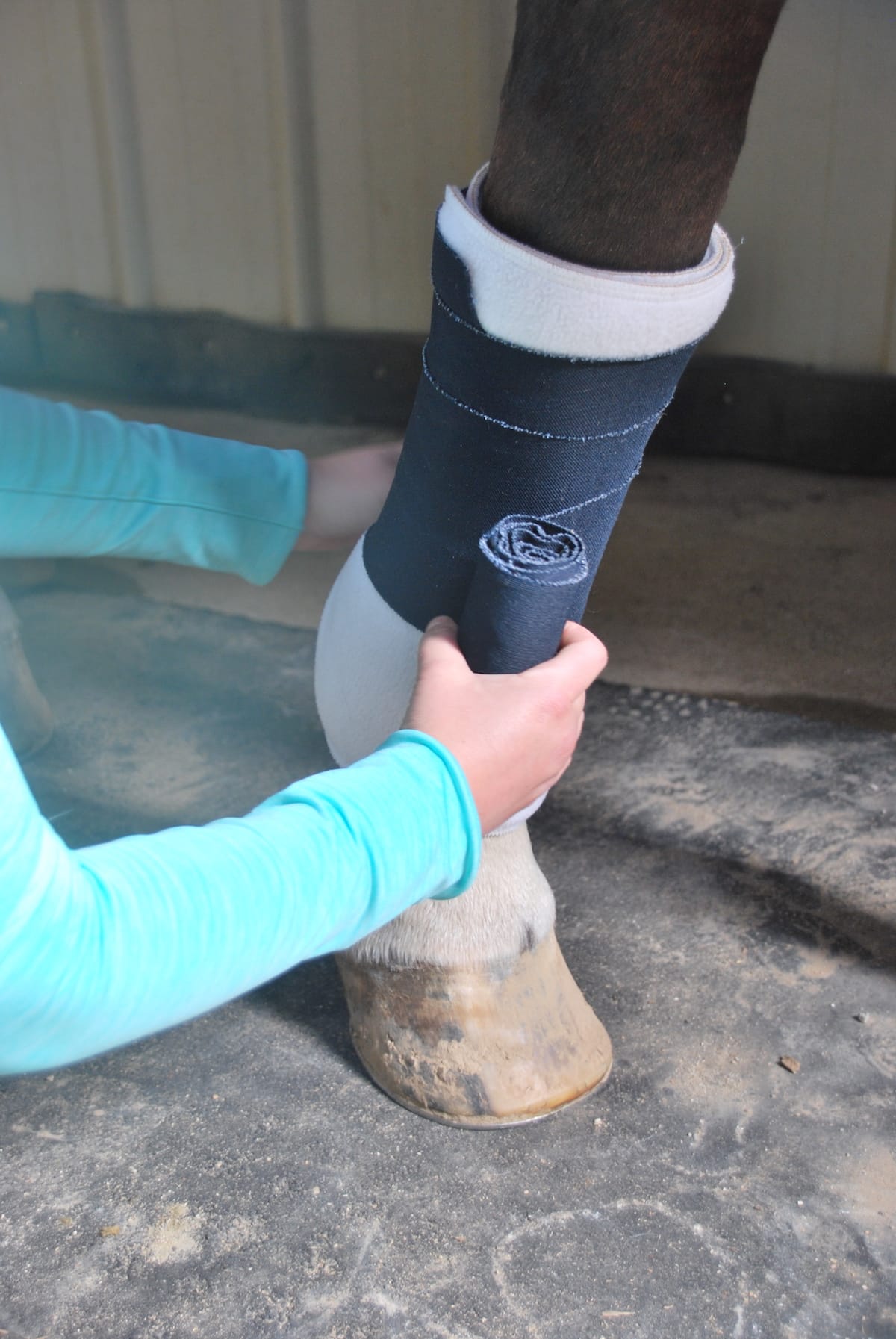
Having all your wound care supplies prestocked and in one spot makes cleaning and bandaging quicker and easier. Courtesy The Horse staff
Learn Important Skills
Barrett and Bryk-Lucy agree that it’s helpful for equestrians to be comfortable monitoring their OTTBs’ vital signs. “The most important skill for the horse owner is the physical examination (PE),” Bryk-Lucy says. “The PE is a simple skill that can give both owner and veterinarian valuable information about the horse’s health. At the most basic level, a PE includes temperature, heart rate and respiration rate.”
With a trained horse owner, Bryk-Lucy also likes to know about gut sounds, digital pulses and mucous membrane color. “Practice gathering these values so you become familiar with what’s ‘normal’ for your individual horse,” she says. “This will allow you to recognize anything out of the ordinary and evaluate the severity of the condition.”
She adds that in her experience, knowing how to pull a shoe, wrap a foot, clean a cut and administer both oral and intramuscular medications are all skills that can come in handy.
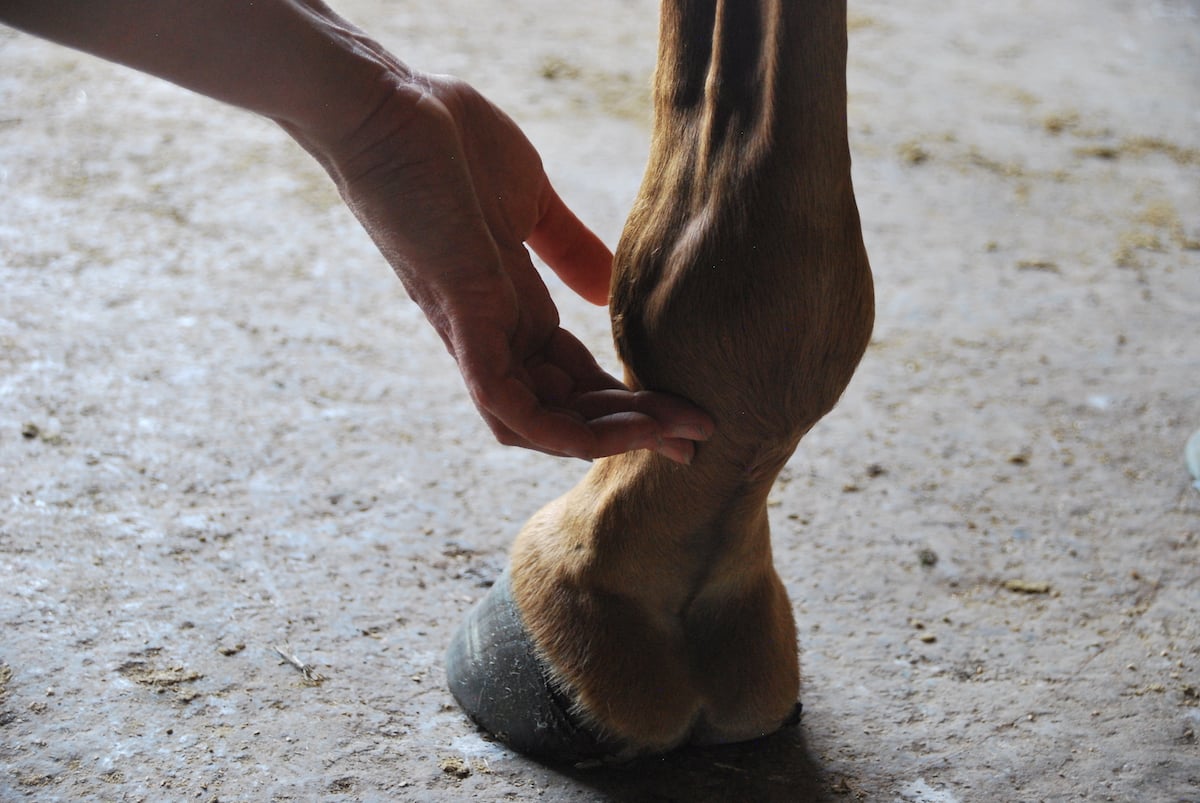
Know how to take vitals, such as temperature, heart rate, respiration rate, digital pulse (shown), gut sounds and mucous membrane color so you can relay that information to your veterinarian. Courtesy The Horse staff
Understand Your Kit’s Function (and Limitations)
Your carefully crafted first-aid kit plays a crucial role. Learning how to stock and use it correctly will help prepare you for any bumps in the road. But no matter how well-versed you are at using these supplies, their availability is never intended to replace veterinary care. Some things are best left to the expert hands of the doctor, such as:
1. Intravenous (IV) injections Improperly done, an IV injection can have serious side effects and can even be fatal.
2. Antibiotics “Administering an antibiotic without a specific prescription can lead to bacterial resistance,” Barrett cautions.
3. NSAIDs Like all medications, Bute and Banamine have potential side effects. These can range from gastric ulcers to kidney damage, depending on dosage, frequency of administration and the individual horse. Consult your veterinarian before administering these medications, and never overuse them.
4. Ointments on wounds If you’re unsure whether a wound needs to be sutured, consult your vet, and don’t put anything on it. Applying a sticky substance to a wound makes it much harder to suture.
“My rule of thumb is, if an owner is questioning whether they should call their veterinarian, they should,” Bryk-Lucy says. “A veterinarian would rather come out to treat what turns out to be a minor injury than to try to fix a larger issue that should have been seen initially. Early treatment is also the smarter financial decision in the long run.”
Have a first-aid kit so you are ready to address your Thoroughbred’s emergency, and gather important information to relay to your veterinarian so he or she can decide how to proceed. Keep it well-stocked and accessible, and get comfortable using it.
Editor’s note: This information is not meant to substitute veterinary care. Always follow the instructions provided by your veterinarian.
Normal TPR in healthy adult horses at rest
Temperature: 99-101.5 degrees Fahrenheit.
Heart rate: 28-44 beats/minute
Respiratory rate: 10-24 breaths/minute
This article was originally published in the Spring 2021 issue of Off-Track Thoroughbred Magazine, the only publication dedicated to the Thoroughbred ex-racehorse in second careers. Want four information-packed issues a year delivered to your door or your favorite digital device? Subscribe now!

